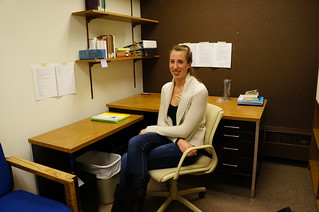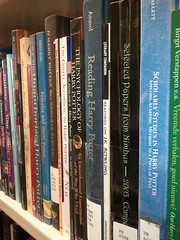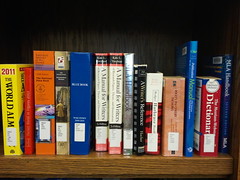
Do you know that the Seeley G. Mudd library has nine individual study rooms that can be assigned to students on a term-by-term basis? More information about our student offices, as well as the student office request form, can be found here.
Allison Juda applied for a student office at the beginning of Winter Term to facilitate her work on her senior honors project. She is an English major and an anthropology minor from Maple Grove, MN, a Northwest suburb of Minneapolis. Read on to learn more about what Allison is researching in her student office in the Mudd!
Allison, tell us about your research.
I am currently working on a senior honors project about the portrayal of Jane Austen’s heroines and how their individual growth out of a position of liminality is reflected in many ways in societal growth so that by the end of the novels both the heroine and community are corrected and society operates once again with morality and decorum. In doing this I am combining theories of liminality produced by notable anthropologists and historical information about social structures in Austen’s time period, as well as some research on Austen herself.
What are you hoping to learn or gain from this research?
I noticed that all of Austen’s novels seem to follow a similar plot structure, so my main goal was to discover why Austen continued to write about the same worlds and journeys, and how that was reflective of literary, and also Austen’s contemporary, society.
Why do you think this research is important?
There has been a lot of research on Jane Austen, especially since the most recent trend of producing Austen movies (as well as other movies from her time period), but I think that not enough research has focused on the reasons why the heroines must go through their journeys. One of the most important things that I want to draw out in my work is an emphasis on the fact that these heroines are a product of their surroundings and that the growth of the social structure is instrumental in the growth of the liminal heroine. In this way, Austen’s literature is an important product of its era; in examining her literature we can learn more about her time period and social structures in general.
How did you become interested in this line of research?
After reading my first Austen novel, Pride and Prejudice, I was drawn into her literary work. As I entered the rabbit hole I became more fascinated with examining the works from a critical perspective and so I approached my advisor about working on the topic in greater detail.
What library materials and resources have been the most useful to you in pursuing this research?
I think that the physical building itself, with great places to study is a huge asset to anyone doing research, big or small. Having a place to go to know that I am going to do work is very important in helping to keep me focused. I also have taken advantage of the expertise of the reference librarians, who have helped point me in the right direction in my research, and the ILL system to get access to important works that we do not have here in Mudd.
What I am perhaps most thankful for is my library office; I have two large binders with research and various drafts and well over a dozen books with which I have been working on a regular basis. Having a place to keep all of my materials safe has been a savior both on my sanity and my back (I don’t think that my poor backpack could make it without my office either).
What would you like your fellow students to know about the Mudd Library?
I think that something I didn’t realize my freshman year at Lawrence is that returning to the same place to study (and only study) on a daily basis really helps me get into the mindset and stay focused while I am doing my work. Studying in the library provides you with all the resources you need in the same place, from the librarians to help you if you get stumped, the scanners, printers, hole punches, staplers, and even the occasional piece of candy.










